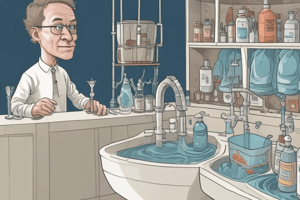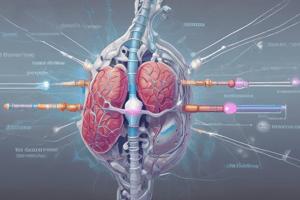Podcast
Questions and Answers
What percentage of body weight is total body water?
What percentage of body weight is total body water?
- 70%
- 50%
- 80%
- 60% (correct)
What is the normal daily requirement of water for adults in terms of body weight?
What is the normal daily requirement of water for adults in terms of body weight?
- 24 to 72 mL/kg (correct)
- 48 to 144 mL/kg
- 12 to 36 mL/kg
- 96 to 288 mL/kg
Why is water administered parenterally as a solution with dextrose or electrolytes?
Why is water administered parenterally as a solution with dextrose or electrolytes?
- To increase the risk of water intoxication
- To maintain isotonicity (correct)
- To provide a source of energy
- To make it easier to store and transport
What is the purpose of initial replacement therapy in patients with severe diarrhea or vomiting?
What is the purpose of initial replacement therapy in patients with severe diarrhea or vomiting?
What is the percentage of body weight that is plasma water?
What is the percentage of body weight that is plasma water?
What is the blood volume in terms of body weight?
What is the blood volume in terms of body weight?
What is a potential consequence of severe potassium loss?
What is a potential consequence of severe potassium loss?
What can cause hyperkalemia?
What can cause hyperkalemia?
What is the recommended infusion rate for intermittent potassium replacement therapy in patients with hypokalemia?
What is the recommended infusion rate for intermittent potassium replacement therapy in patients with hypokalemia?
Why must potassium preparations be diluted with a suitable large-volume parenteral solution?
Why must potassium preparations be diluted with a suitable large-volume parenteral solution?
What is the most commonly used concentration of potassium chloride for continuous-infusion maintenance therapy?
What is the most commonly used concentration of potassium chloride for continuous-infusion maintenance therapy?
What is a symptom of potassium deficiency?
What is a symptom of potassium deficiency?
How does the total plasma calcium level vary?
How does the total plasma calcium level vary?
What is the primary focus of maintenance fluid therapy?
What is the primary focus of maintenance fluid therapy?
What is a key difference between irrigation and dialysis solutions and parenteral preparations?
What is a key difference between irrigation and dialysis solutions and parenteral preparations?
What is the purpose of irrigation solutions?
What is the purpose of irrigation solutions?
What factor determines the optimal fluid type for maintenance or replacement therapy?
What factor determines the optimal fluid type for maintenance or replacement therapy?
What is the purpose of Acetic acid irrigation, USP?
What is the purpose of Acetic acid irrigation, USP?
What is the typical packaging of irrigation and dialysis solutions?
What is the typical packaging of irrigation and dialysis solutions?
What type of antibacterial properties does Neomycin and Polymyxin B sulfates solution for irrigation, USP possess?
What type of antibacterial properties does Neomycin and Polymyxin B sulfates solution for irrigation, USP possess?
What are the components of Ringer's irrigation, USP?
What are the components of Ringer's irrigation, USP?
What is the purpose of labeling Ringer's irrigation, USP as 'NOT FOR INJECTION'?
What is the purpose of labeling Ringer's irrigation, USP as 'NOT FOR INJECTION'?
What is the common purpose of Neomycin and Polymyxin B sulfates solution for irrigation, USP and Ringer's irrigation, USP?
What is the common purpose of Neomycin and Polymyxin B sulfates solution for irrigation, USP and Ringer's irrigation, USP?
What is the common characteristic of all the irrigation solutions mentioned?
What is the common characteristic of all the irrigation solutions mentioned?
What is the primary concern when administering drugs in small quantities?
What is the primary concern when administering drugs in small quantities?
Why is it essential to use specific materials for administering Nitroglycerin (NTG)?
Why is it essential to use specific materials for administering Nitroglycerin (NTG)?
What is the purpose of using short lengths of small diameter tubing in parenteral therapy?
What is the purpose of using short lengths of small diameter tubing in parenteral therapy?
What is the primary concern in I.V. admixture?
What is the primary concern in I.V. admixture?
What is the primary purpose of hemodialysis?
What is the primary purpose of hemodialysis?
What is the difference between maintenance replacement therapy and initial replacement therapy?
What is the difference between maintenance replacement therapy and initial replacement therapy?
Flashcards are hidden until you start studying




